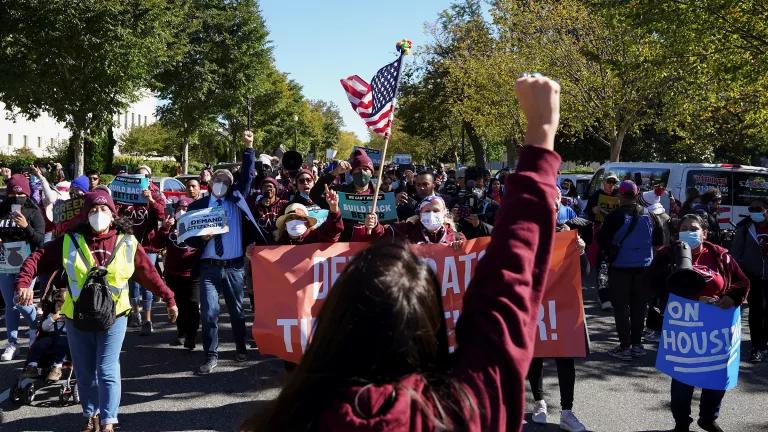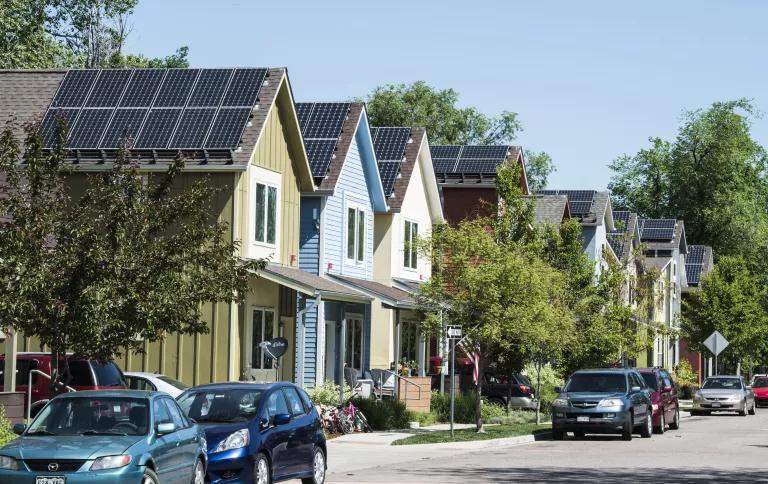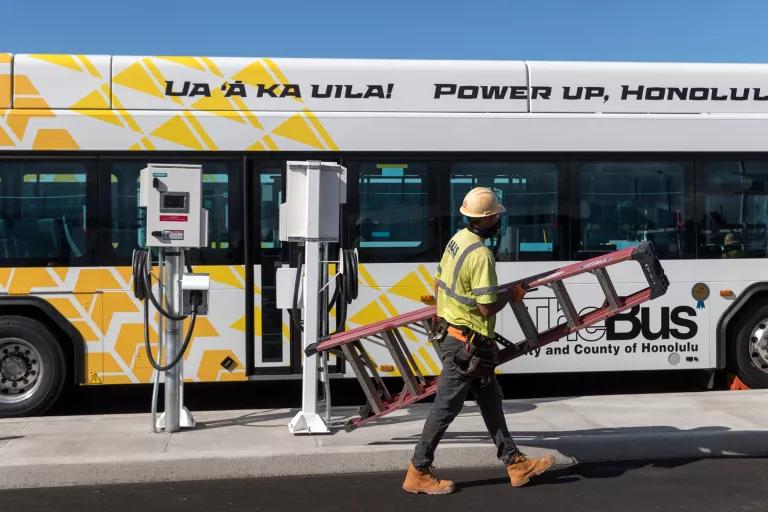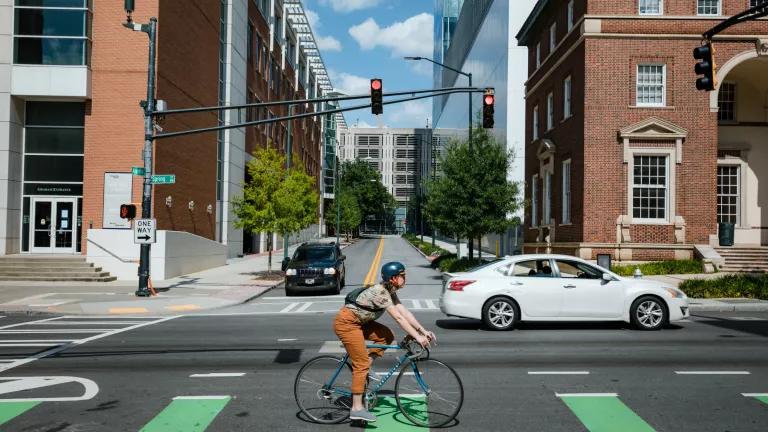House Passes Historic Climate Action in Build Back Better Act
Now we’re counting on the Senate to deliver on the country’s most consequential climate legislation ever.

Activists march to demand Congress pass the Build Back Better Act, which provides a transformational investment in workers, communities, and the environment, Washington, D.C., October 27, 2021.
On Friday, the U.S. House of Representatives passed the most consequential climate legislation in the country’s history, sending the Build Back Better Act to the Senate. With a crisis this urgent, stakes this high, and opportunity so far reaching, the Senate has no more pressing business before it than to pass this bill without delay.
The bill calls for strategic investment to cut the dangerous carbon pollution that’s driving the climate crisis, in a way that will create high-quality jobs, drive innovation, and advance equity.
This is what voters expect from Congress: to enact legislation that helps the nation tackle big problems, seize opportunities, and embrace a more promising future.
That’s what the Build Back Better Act is all about.
It calls for $555 billion in climate investment—the largest ever—to help us get more clean power from the wind and sun, speed the shift to electric vehicles, and make our homes and workplaces more efficient. It invests in strengthening public transit, expanding affordable housing, and cutting pollution in disadvantaged communities. And it will create millions of jobs, including for those who choose to be represented by a union.
And because reducing carbon emissions also cuts other dangerous air pollution, it will dramatically reduce asthma attacks, heart disease, missed days at work or school and even premature deaths. These maladies impact all of us, but they disproportionately hit low income communities and people of color who live with higher levels of such pollution, on average, than their white counterparts.
The Build Back Better Act is the centerpiece of President Biden’s climate strategy to cut greenhouse gases 50–52 percent and deliver 80 percent clean electricity by 2030.
To get it done, we’ll also need ambitious new federal standards to cut carbon pollution and protect public health. We’ll need our public lands and federal ocean waters to become part of the climate fix, not the problem. And we’ll need to align the policies, decisions, and actions of every federal agency with our national climate goals.
That’s the grand strategic vision Biden brings to the climate fight. It starts with the Build Back Better Act the House passed Friday.
It provides the largest public investment ever to help clean up the electric power sector that accounts for nearly a third of the nation’s carbon footprint. Confronting the climate crisis means cutting that carbon pollution. The Build Back Better Act provides powerful incentives to help utility companies do that, by pivoting to renewable energy sources like the wind and sun.
Over the past decade, wind and solar power have grown fivefold, together accounting for 12 percent of the nation’s electricity, as costs have fallen, respectively, 70 percent and 90 percent in that same time.
The Build Back Better Act will help to build on that momentum and accelerate sustained progress. It includes investments in research and development to help drive the innovation we need to make the United States the world leader in wind and solar power, electricity transmission and storage, and other transformative clean energy technologies.
Paired with strong standards, the power sector investments in the Build Back Better Act will, if enacted, create up to three million high-quality domestic jobs by 2030, while adding as much as $445 billion to the economy in that year alone, NRDC analysis shows.
Two additional keys to cutting our carbon footprint are getting solar panels on homes and electric cars and light trucks on the road. The Build Back Better Act includes tax credits that can cut the cost of installing rooftop solar panels by about 30 percent, while offsetting the price of a new electric car by up to $12,500 for a middle-class family buying a U.S.-made vehicle built by union workers.

Rooftop solar panels on affordable, energy-efficient homes in Red Oak Park, Boulder, Colorado
The bill also boosts investment to help weatherize homes and put energy efficiency within reach for low-income and middle-class families, contributing to an estimated $500 per household in annual savings on energy bills. And it provides historic investments to improve lives—and save lives—for low-income communities and people of color on the frontlines of climate hazard and harm.
The bill includes, for instance, incentives to help strengthen the domestic supply chain for wind and solar power in disadvantaged communities. It calls for important investments in public transit, to improve service and access to affordable mobility for everyone, especially the people of color who make up 60 percent of public transit riders.

A worker installing a charging station for electric buses at a Transit Center in Honolulu | Marco García for NRDC
It will help to reconnect low-income communities that were gutted decades ago by misguided highway routes. It will coordinate public transit access with needed investment in low-income housing by bundling preservation or construction of affordable homes with new or enhanced train stations and bus stops.
All of this matters if we’re serious about addressing inequality, creating jobs, strengthening the economy, and confronting the climate crisis. That’s what the Build Back Better Act will do, thanks to the House members who passed it.
It will only happen, though, if the Senate follows suit.
Climate change is the existential challenge of our time. The Build Back Better Act is the centerpiece of a grand national strategy to confront that challenge and to do so in a way that creates jobs, strengthens the economy, and invests in a healthier, more equitable, more promising future.
That’s what voters expect from Congress. The House delivered on Friday—it’s time for the Senate to do the same.



